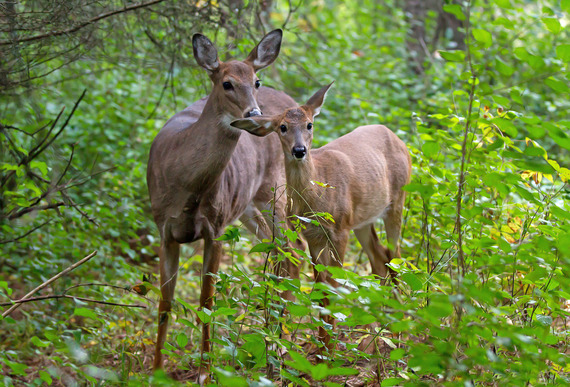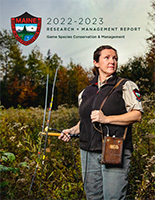Thank you for your submissions!
 On behalf of Maine Department of Inland Fisheries and Wildlife, thank you for taking some time to record and submit your 2023 deer observations through the Deer Spy project. This was the 4th year for the project, and our observation window was August 1 ? September 30. A total of 1,410 observations were submitted this year, up from 1,179 in 2022. These observations included 4,011 deer.
|
? ? ?WMD? ? ?
|
? # of Observations? ?
|
? ? ?WMD? ? ?
|
? ? # of Observations? ? ?
|
|
1
|
9
|
16
|
104
|
|
2
|
3
|
17
|
67
|
|
3
|
8
|
18
|
23
|
|
4
|
5
|
19
|
2
|
|
5
|
2
|
20
|
88
|
|
6
|
52
|
21
|
191
|
|
7
|
5
|
22
|
152
|
|
8
|
6
|
23
|
66
|
|
9
|
8
|
24
|
90
|
|
10
|
1
|
25
|
122
|
|
11
|
5
|
26
|
116
|
|
12
|
38
|
27
|
24
|
|
13
|
89
|
28
|
8
|
|
14
|
5
|
29
|
1
|
|
15
|
120
|
Total
|
1,410?
|
?
Quality control was conducted to ensure data correctness (e.g.- removing entries where a doe with fawns was reported but no fawns were reported or vice versa) and to avoid over-representation of individuals or areas.
Observations were submitted by 541 different participants (534 online survey, 7 postal mail). This means that each observer submitted an average of 2.8 observations. Raw data before quality control included 1,983 does, 1,153 fawns, 358 bucks, and 517 deer of indeterminate sex and age. Most of our observations come from central and southern Maine where there are both more deer and more people. Northern Maine data is always a challenge to come by.
Observations of single does give us some idea of what percentage of does have successfully raised fawns up until the fall, and among the does that have successfully raised fawns, how many fawns they have raised. This year, observations of 771 single does were reported, and 404 of these (52.4%) were does with fawns alongside. This compares with 55.3% last year. Among the 404 single does with fawns were 611 fawns. If we account for the fact that not every doe successfully raises fawns, include our estimate of fawns per doe, and account for a little bit of mortality that may still occur between the end of the observation period and the start of fall, our statewide estimate of fawns raised per doe was 0.75. This compares with 0.86 in 2022 and 0.81 in 2021. While this lower recruitment estimate is not good news in that it means there was lower fawn survival this year, it is good news in that it increases confidence in our data quality; the peak birthing period for our does in Maine is early June, which was extremely wet and cold this year. These poor fawning conditions were expected to limit recruitment, and actually seeing that appear in the data that you all collected is very encouraging to see. Among the does that successfully raised fawns, the percentage of does successfully raising just one fawn was higher this year as well, meaning fewer does successfully raised twins or triplets (see figure at bottom).
 |
These summary results will be available in our next MDIFW Research and Management report. Past reports can be viewed online. We will continue to refine the survey as need arises and consider other summary information that may be of interest to the Department, project participants, and wildlife enthusiasts around Maine. |
|
 |
 |
|
If you enjoyed watching deer this summer, please consider contributing to one of our other community science projects.
Choose a project that most interests you and get started today!
|
We hope it was enjoyable and that you?ll consider contributing again.
|
